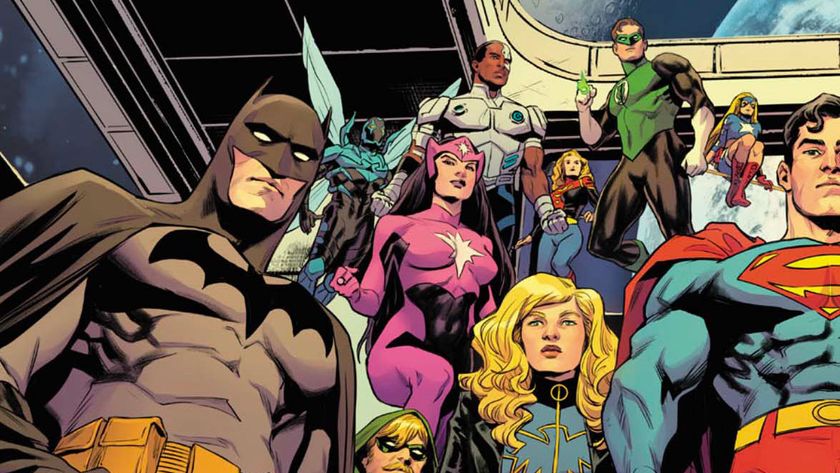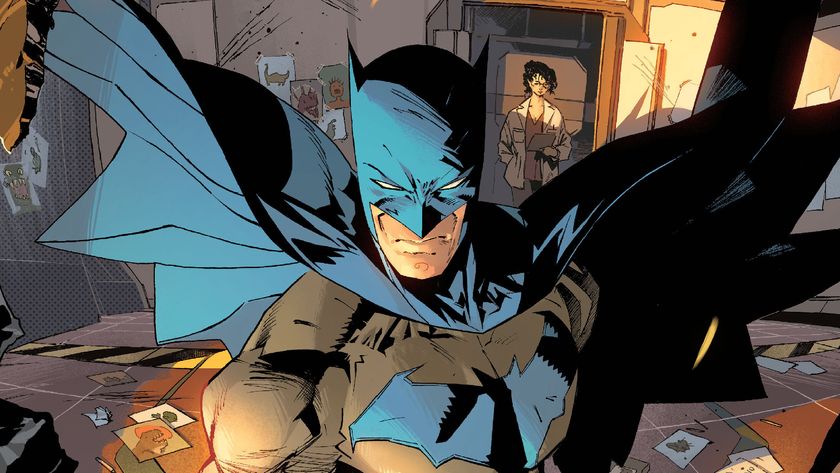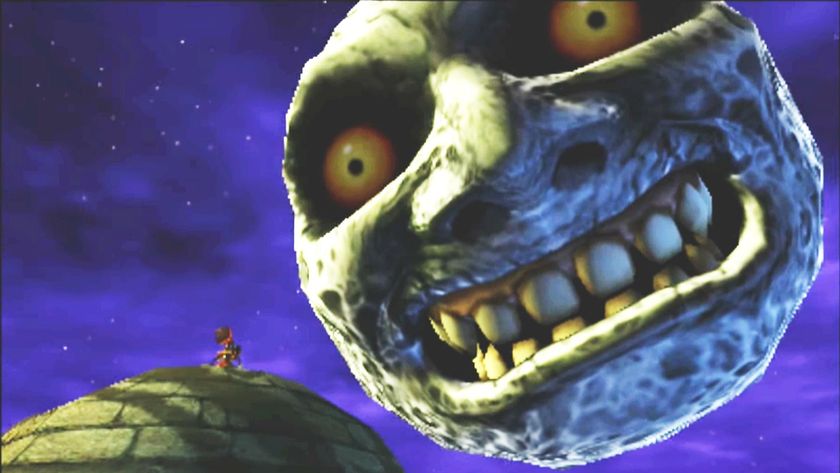Dark Crisis creators pay tribute to the original Crisis and tap into Titans history in issue #2
Daniel Sampere and Joshua Williamson talk us through Dark Crisis #2
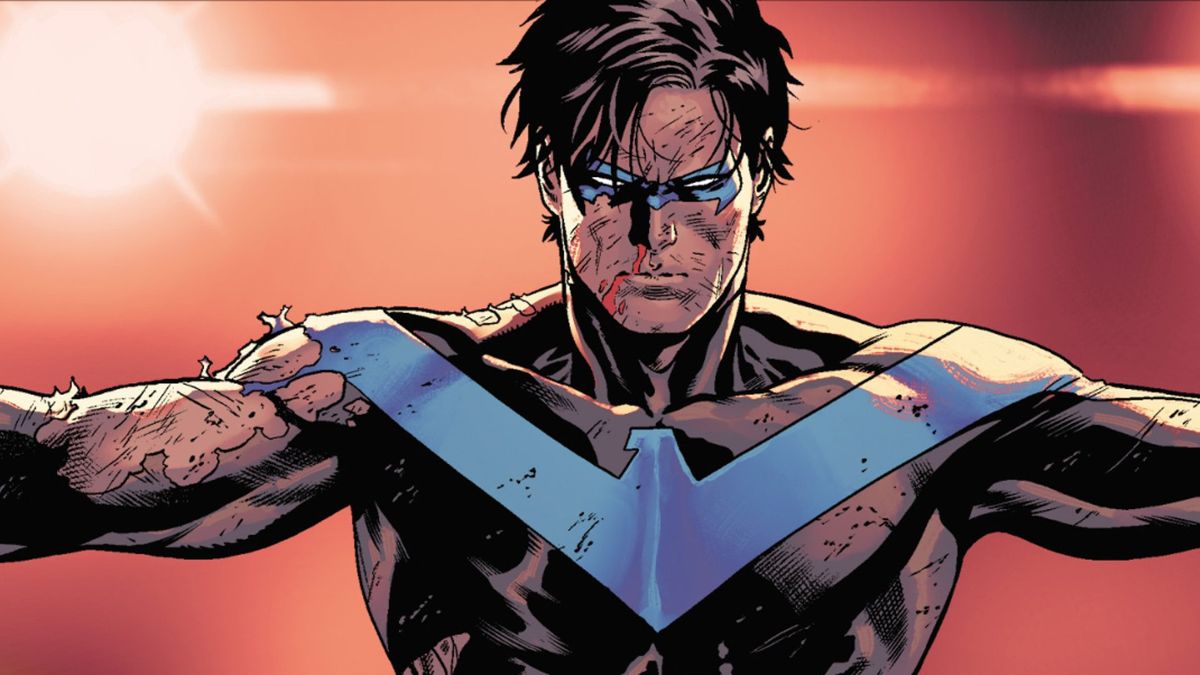
Despite months of lead-up to Dark Crisis, nothing could have prepared readers for the ending of the first issue. Deathstroke and his newly formed Secret Society of Supervillains have sieged Titans Tower, causing massive destruction and maybe even a death or two. It's a a heck of a cliffhanger, but thankfully, our answers are finally here.
Dark Crisis #2 was drawn by Daniel Sampere, written by Joshua Williamson, colored by Alejandro Sánchez, lettered by Tom Napolitano, and hit comic stores everywhere July 5. Newsarama sat down with Sampere and Williamson to get the low-down on the book, talk about creating a crisis, and hear how the issue pays tribute to the late George Pérez.
Read on for more, but beware, some very minor spoilers for Dark Crisis #2 follow.
Grant DeArmitt for Newsarama: Joshua, Daniel, Dark Crisis #2 is a very emotional issue, not just because of its content but because of some of the artwork that appears in the beginning. On the first few pages, we see several panels labeled 'After Pérez.' This is of course a tribute to DC legend and Crisis on Infinite Earths artist George Pérez. Can you talk about how those panels came to be?
Daniel Sampere: Well, the script said that we need to use those panels from Crisis on Infinite Earths. And I was like, yeah, I'm not going to change these panels because they are perfect. I am going to redraw them, with all of my respect. I need to put 'After Pérez,' of course, because everyone needs to know that these panels are not mine. These are from the master.
It was amazing; I felt super lucky to have the chance to pay tribute to him and 'Crisis.' People who have already read the issue know the fight scenes, know the Deathstroke pages, but I really like what's on that first page.
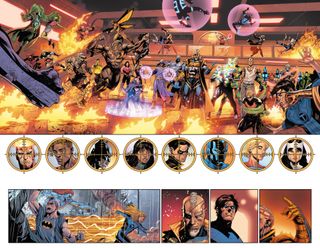
Nrama: Do you find yourself thinking about George Pérez's work from Crisis on Infinite Earths a lot as you are working on this?
Comic deals, prizes and latest news
Get the best comic news, insights, opinions, analysis and more!
Sampere: Yes. Now I even respect him more than I already did, because I feel how hard it is to do something like this. And he did better than anyone. There are so many characters in that Crisis, there are even more than ours. On every panel, even on super little panels there's so much going on, but you don't feel lost at any moment when reading. You know exactly what's going on. It feels like magic.
So I'm not trying to do something like he did because it would be foolish on my side. I'm just trying to draw the best I can. But I do study what he did, and I try to learn as much as I can. And I just play my cards, you know, with all respect for the previous work.
Joshua Williamson: That original work, it's a masterpiece. There is nothing like it. Any page of that book is amazing. There are no misses, ever. When you look at it, you're just like, this thing they did is really special. It is a masterwork, and there's never been an event that has gone for it the way it did.
And it's not just an event. It's a comics' cultural milestone. It's such a marker, you know, there is Pre-Crisis and there is Post-Crisis. That's a real thing. The stuff that George Pérez was doing… it's intense to look through sometimes. I try to look at it whenever I'm writing one of the issues. I flip through it and there were times when Daniel and I did Zoom calls and I just grabbed a page and held it to the camera like, 'This, this, this.'
But what Daniel was saying is that just trying to copy it would be foolish. We try to invoke the same kind of feelings that book invokes in us; that's what our goal is, to then put that on other people. And with this issue, you have the Titans focus, which is also such a part of George Pérez's legacy. It makes sense to pay homage to him at the beginning.
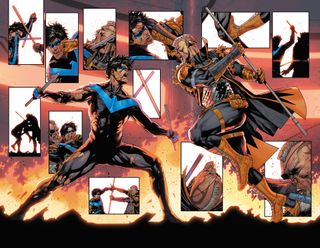
Nrama: That's great you bring that up because I wanted to ask: What from Titans' history are you putting into this book?
Williamson: Well, I came into Titans a little bit late. I started reading Titans in the late '80s, early '90s, so my Titans reference was from that particular period. Then I started reading Geoff Johns's launch of Titans in 2003, and I liked the union between the Young Justice characters and the classics like Starfire and Cyborg, that idea of combining these different mythologies of Titans together. That's always something that's really stuck with me.
It was probably in the early 2000s that I finally went back and started reading the George Pérez and Marv Wolfman stuff. That wasn't really as readily available as it is today. But those early issues probably have a bigger influence on me, especially the first issues. Those are the ones that I look at a lot. Like, not everything has to be a big event or a big story. I liked some of the smaller moments in that Titans run, like the issue when Dick is planning his wedding. The story is how [the Titans] interact with him planning the wedding. That impacted my view of the Titans.
In the last couple of years, I've gone through and read issues and stories every once in a while, just to get a feel of how these characters were with one another. I looked at Titans Academy and talked to Tim Sheridan a little bit about how to use those characters, and made sure that we were respectful with the stuff he was doing because I really like that book and Tim Sheridan a lot. And I wanted to honor it.
A big part of the crisis is just to look at everything that happened in DC in the last year, and try to have all of that, at least in some way, inform the story. So it was a lot of going through and reading things and talking to Tim and talking to editorial.
Nrama: History is definitely such an important thing in this book. Well, the Titans aren't the only super team that we see in this issue. We also see a new Secret Society of Supervillains in Dark Crisis #2, and their line-up is stacked. How do you make the choices as to who is in there?
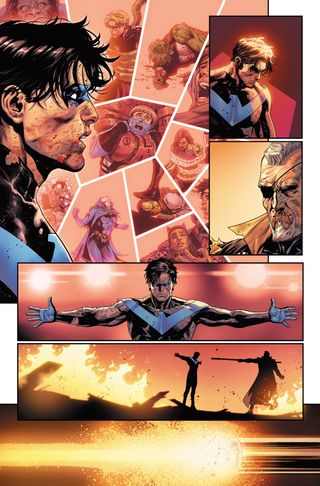
Sampere: It's a mix between my own will and what the script demands. In some panels, this character needs to talk, or this character is with this other one, so I need to put them in there. It depends on the situation. But there are other panels where I need to show a lot of people and I try to add variety, to not use the same characters because it will look boring.
Sometimes I just draw the ones that I think look cool, as simple as that. Sometimes I'm in a rush and I make the bigger guy the easiest one to draw. So it just depends on what the story demands and my timing and my personal feelings for the characters. It's like figuring out a puzzle with a lot of different aspects. I'm putting someone over here and over there and over here. It's a lot of fun; figuring this stuff out is one of the most enjoyable parts of the work.
Williamson: I was working on Deathstroke Inc., and we knew that Deathstroke is eventually going to have this huge army. So last summer, we made this huge list of all the villains we were going to use. They were Deathstroke's lieutenants, his heavy hitters, and the actual army itself. We broke the list up into, like, characters who can fly, characters who have guns, characters who have powers. It was broken up into groups so that Daniel had some insight into them. Watching Daniel do this, it's interesting because he'll go and do his own research on that villain and then put that into something we are doing.
Back in December, we did a Zoom with Phil Jimenez to get his advice. And one of the things that Phil talked about was that one of the fun parts of doing a Crisis is showing a character that you might not expect to do something really interesting or dynamic. Or showing two characters interact with each other that you've never seen before. That impacted some of the stuff in my head, and that's why I wanted to showcase some of these characters.
Later on, you'll get to see some villains interact that you've never seen interact. There's some stuff way later, I think, when we get to some of the even bigger fights that'll happen, that you'll get to see some interesting combinations between characters.
Also, it's fun to showcase these lesser-known villains in these roles, because you might be like, 'Who is that character?' That might make you curious and make you want to read their stuff.
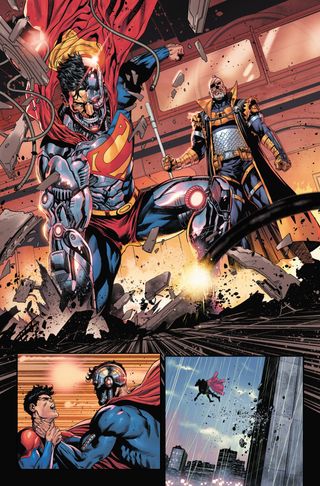
Nrama: That's a cool way of thinking about a Crisis even. I don't think people would think about that unless they were actually working on one. Well, only two issues in and Dark Crisis is already sticking out in the memory of comic book readers. A milestone, like you said earlier. So let me pose this to you: Thirty years in the future, when DC is doing a Crisis that harkens back to Dark Crisis like this one harkens back to Crisis on Infinite Earths, what do you think will be your panels that get repeated? What do you think will be your 'After Pérez' panels?
Sampere: The first spread on the first issue… the DC legacy scene, remember? I tried to make that one, like, I'm going to make an iconic poster to be part of DC history, as good as I can do it. I would like to see it in the future as established imagery for DC. But maybe that's asking too much. Time will tell.
I also love the ending of issue #2. I like the moment when Cyborg Superman shows up. It's a cool moment.
Nrama: I don't think it's asking too much at all, that page is absolutely iconic. Alright, last question. Joshua, you revealed on Twitter that the JSA will show up in Dark Crisis. Now, so much of this book is about how to handle a Crisis. Jonathan Kent thinks he needs to form a new team, Dick Grayson thinks he just needs to hold down the fort until the Justice League gets back. How is the JSA going to answer the Dark Crisis question?
Williamson: There's a scene in issue #4 where Alan Scott is talking to Nightwing, and he says that all these things are just labels. Everyone here is a capable hero; it doesn't matter if you call us the Justice League, or Titans, or JSA. We've all been through hell before. What's important is that we do it together. That's where the JSA comes in. They bring calmness and a different perspective.
In issue #3, there are a lot of moral defeats among the groups of heroes. And I think [the JSA] are the ones that pull them out of that moral defeat by saying, 'Let's just do this together. Let's all be together.' That's how I see them.
Nrama: Awesome. Well, that just about wraps up my questions, is there anything you would like to leave us with?
Sampere: Just keep breathing. Because things are going to get… interesting.
How will Dark Crisis rank amongst every DC Crisis event ever?

Grant DeArmitt is a NYC-based writer and editor who regularly contributes bylines to Newsarama. Grant is a horror aficionado, writing about the genre for Nightmare on Film Street, and has written features, reviews, and interviews for the likes of PanelxPanel and Monkeys Fighting Robots. Grant says he probably isn't a werewolf… but you can never be too careful.
Most Popular





